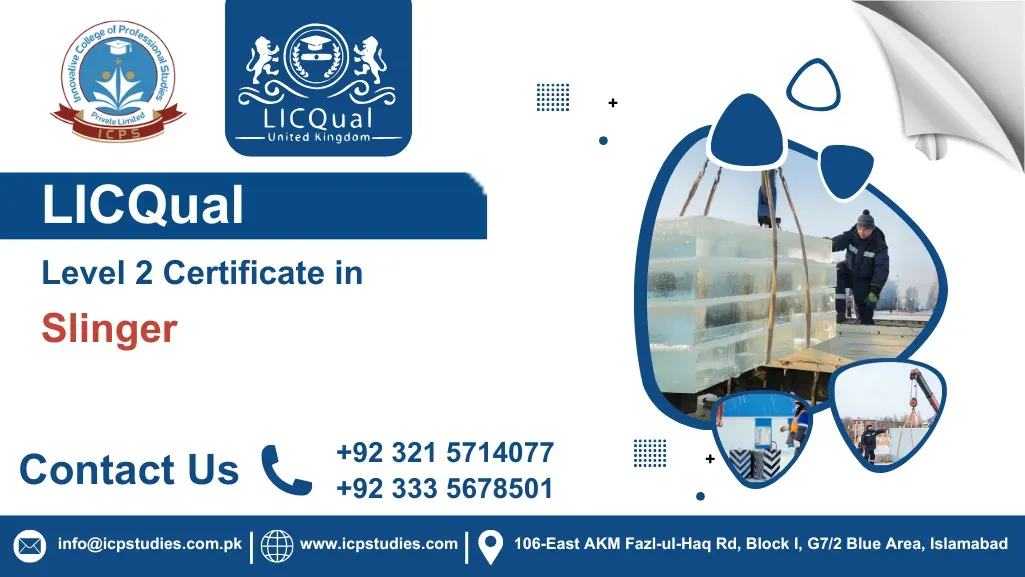The LICQual Level 1 Certificate in Slinger is an entry‑level certification designed to provide learners with the essential knowledge and practical skills required to support safe lifting operations. This program introduces participants to the fundamental responsibilities of a slinger, focusing on preparing loads, attaching lifting equipment, and guiding lifting activities under supervision. Learners will gain a clear understanding of the importance of safety awareness, teamwork, and effective communication, ensuring they can contribute responsibly to lifting tasks in construction, engineering, logistics, and industrial environments.
The course emphasizes the foundations of slinging practice, including the identification and selection of appropriate lifting equipment, inspection procedures, and the application of safe working loads. Learners will explore how to recognize potential hazards, maintain clear communication with crane operators and team members, and apply basic rigging techniques to secure loads effectively. Practical training forms a core part of the program, allowing participants to apply theoretical knowledge in controlled scenarios. Through hands‑on exercises, learners will develop confidence in their ability to work safely and efficiently as part of a lifting team, while understanding the impact of correct and incorrect slinging methods on operational success.
Upon successful completion, participants will achieve the LICQual Level 1 Certificate in Slinger, a credential that demonstrates their readiness to perform basic slinging duties with professionalism and responsibility. This certificate enhances employability in industries where lifting operations are integral and validates a learner’s commitment to safe working practices. It also provides a strong foundation for individuals who wish to build their career by pursuing related certifications and diplomas such as LICQual Level 2 Diploma in Rigging and Slinging, Health and Safety Awareness Certificates, or Construction Skills Diplomas. These further certifications allow learners to expand their expertise and strengthen their credibility within the field of lifting operations and workplace safety.
All About FAQs About LICQual Level 2 Certificate in Slinger
Course Overview
The LICQual Level 1 Certificate in Slinger is an introductory certification designed to provide learners with the essential knowledge and practical skills required to support safe lifting operations. This program introduces participants to the fundamental responsibilities of a slinger, including preparing loads, attaching lifting equipment, and guiding lifting activities under supervision. It emphasizes the importance of safety awareness, teamwork, and effective communication, ensuring learners can contribute responsibly to lifting tasks in construction, engineering, logistics, and industrial environments.
The qualification is structured into 6 units, each carefully designed to cover the core aspects of slinging practice. Learners will progress through topics such as slinging and signalling basics, safe lifting practices, equipment selection and inspection, rigging techniques, communication skills, and safety regulations. With a total of 18 credits, the program provides a balanced combination of theoretical knowledge and practical competence, ensuring learners achieve a recognized standard of proficiency in entry‑level slinging operations.
The course requires 72 Guided Learning Hours (GLH), making it comprehensive yet accessible for individuals who are new to the industry or seeking to formalize their skills. Delivery methods may include classroom instruction, supervised practical training, and scenario‑based exercises, allowing learners to apply their knowledge in real‑world contexts. This blend of theory and practice ensures participants develop confidence in handling lifting tasks while adhering to workplace safety requirements and industry expectations.
By completing the LICQual Level 1 Certificate in Slinger, learners will gain a professional credential that validates their ability to perform basic slinging duties responsibly and effectively. This certificate enhances employability in sectors where lifting operations are integral and demonstrates a commitment to safe working practices. It also provides a strong foundation for individuals who wish to build their career by pursuing related certifications and diplomas such as LICQual Level 2 Diploma in Rigging and Slinging, Health and Safety Awareness Certificates, or Construction Skills Diplomas, supporting career growth and professional recognition within the field.
To ensure learners are suitably prepared for the LICQual Level 1 Certificate in Slinger, applicants should meet the following requirements:
- Age Requirements Learners must be at least 18 years old, reflecting the maturity and responsibility required for safe participation in lifting operations.
- Educational Requirements A basic educational background is required, ideally supported by related vocational certificates or diplomas such as Health and Safety Awareness, Basic Rigging and Slinging Techniques, or Construction Skills Certification.
- Language Proficiency Learners should demonstrate proficiency in English or the language of instruction, with the ability to read, write, and communicate effectively in technical and safety contexts.
- Work Experience While prior exposure to construction, engineering, logistics, or industrial environments is recommended, it is not mandatory. Experience in roles involving lifting operations, equipment handling, or safety compliance will be considered an advantage.
These entry requirements ensure that learners enrolling in the LICQual Level 1 Certificate in Slinger have the maturity, foundational knowledge, and practical awareness necessary to succeed in the program and apply their skills effectively in workplace settings.
The ideal learner for the LICQual Level 1 Certificate in Slinger is someone who demonstrates responsibility, practical awareness, and a strong commitment to safety in lifting operations. This learner is motivated to enhance their competence, contribute to workplace safety, and gain recognition through professional certification.
Professional Background
- Works within construction, engineering, logistics, or industrial environments
- Has prior exposure to lifting operations or equipment handling
- Familiar with workplace safety policies and procedures
- Engages with teams and supervisors in operational settings
- Demonstrates responsibility in managing tasks safely and efficiently
Educational Readiness
- Possesses a basic educational background with vocational training or certificates
- Comfortable with technical learning and safety-related study materials
- Able to interpret operational guidelines and apply them in practice
- Prepared to balance theoretical learning with hands-on application
- Shows readiness to progress into structured certification programs
Personal Attributes
- Committed to promoting safety and compliance in workplace operations
- Displays confidence, focus, and attention to detail in practical tasks
- Demonstrates teamwork and effective communication skills
- Open to feedback and willing to adapt methods for improvement
- Upholds integrity, accountability, and professionalism in all duties
Practical Potential
- Interested in developing competence in slinging and lifting operations
- Motivated to apply safe working practices consistently
- Willing to participate in practical exercises and real-world scenarios
- Capable of managing risks and making informed decisions under pressure
- Seeks to contribute to efficient and safe lifting operations in the workplace
Career Aspirations
- Aims to gain recognition as a certified slinger in construction or industrial sectors
- Seeks opportunities to enhance employability and workplace credibility
- Interested in progressing into supervisory or safety-focused roles
- Motivated to build a career in lifting operations and related fields
- Committed to continuous learning and professional development
The ideal learner for this award is someone who combines practical experience, personal commitment, and professional ambition, with the goal of becoming a competent and certified slinger who contributes to safe and efficient lifting operations across diverse industries.
Study Units
- Advanced Slinging and Signalling Techniques
- Risk Assessment for Lifting Operations
- Equipment Selection and Handling
- Load Stability and Weight Calculation
- Communication and Coordination with Operators
- Legal and Regulatory Requirements
Learning Outcomes
By the end of this course, learners will be able to demonstrate advanced competence in slinging operations, signalling practices, risk assessment, equipment handling, load stability, communication, and compliance with legal and regulatory requirements. Each unit is designed to build both theoretical knowledge and practical skills, ensuring learners can contribute effectively to safe and efficient lifting operations.
Advanced Slinging and Signalling Techniques
- Demonstrate the ability to apply advanced slinging and rigging techniques for complex and oversized loads.
- Understand and implement advanced signalling methods to ensure clear communication with crane operators and lifting teams.
- Assess and adjust slinging techniques based on load type, weight, shape, and environmental conditions.
- Evaluate the safety of lifting operations through proper load distribution and rigging configuration.
- Apply advanced slinging techniques to handle irregular loads and ensure smooth, safe lifting operations.
Risk Assessment for Lifting Operations
- Conduct thorough risk assessments to identify potential hazards in lifting operations.
- Recognize risks associated with equipment failure, load instability, and environmental factors.
- Develop risk mitigation strategies to minimize or eliminate hazards before lifting tasks begin.
- Implement effective control measures to manage risks during lifting operations in compliance with safety standards.
- Adapt risk assessments based on the complexity of lifting operations and varying site conditions.
Equipment Selection and Handling
- Identify the key factors for selecting appropriate lifting equipment based on load specifications and site conditions.
- Demonstrate the ability to inspect and evaluate lifting equipment for wear, damage, and suitability before use.
- Understand the importance of selecting equipment that meets safety requirements and operational limitations.
- Safely handle and operate lifting equipment, ensuring proper maintenance and storage practices.
- Recognize the impact of incorrect equipment selection on lifting operations and overall safety.
Load Stability and Weight Calculation
- Calculate load weights accurately and apply this information to select correct equipment and slinging techniques.
- Understand the factors influencing load stability, including distribution, shape, and lifting angles.
- Demonstrate the ability to maintain load stability throughout the lifting process.
- Assess and calculate the center of gravity of irregularly shaped loads to prevent instability.
- Apply knowledge of weight calculation and stability principles to plan safe and efficient lifting operations.
Communication and Coordination with Operators
- Develop effective communication skills to relay clear instructions and signals to crane operators and lifting teams.
- Utilize appropriate hand signals and verbal communication methods to ensure clarity during lifting operations.
- Coordinate effectively with crane operators to ensure smooth execution of lifting tasks.
- Maintain continuous communication during operations to address issues or changes in real time.
- Ensure all team members understand their roles and responsibilities through clear communication.
Legal and Regulatory Requirements
- Demonstrate a thorough understanding of the legal and regulatory framework governing lifting operations.
- Identify relevant national and international safety standards and regulations applicable to slinging and lifting tasks.
- Understand the responsibilities of employers and employees in ensuring compliance with safety regulations.
- Ensure lifting operations are conducted in line with legal requirements to prevent accidents and penalties.
- Apply industry-specific safety regulations to promote a safe and legally compliant working environment.
These learning outcomes ensure that learners completing the course will possess the advanced technical skills, safety awareness, and regulatory knowledge required to perform slinging and lifting operations with confidence. Graduates will be prepared to contribute to safe, efficient, and legally compliant lifting practices across diverse workplace environments.
FAQs About LICQual Level 2 Certificate in Slinger

